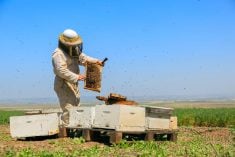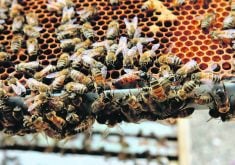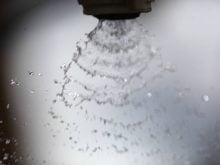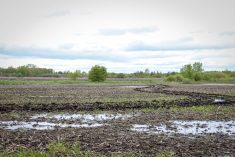The province’s beekeepers may well feel like they dodged a bullet, thanks to a surge of growth in August and September.
Late-season rains helped bolster the 2021 honey harvest and have eased fears about the coming winter, according to Manitoba Beekeepers’ Association chair Ian Steppler.
“The situation earlier in the summer seemed really dire and we were in a state of unknown and, as things kind of played themselves out here, it looks like we were provided with some reprieve and it looks like everybody is going to be in business next year,” he said.
Read Also
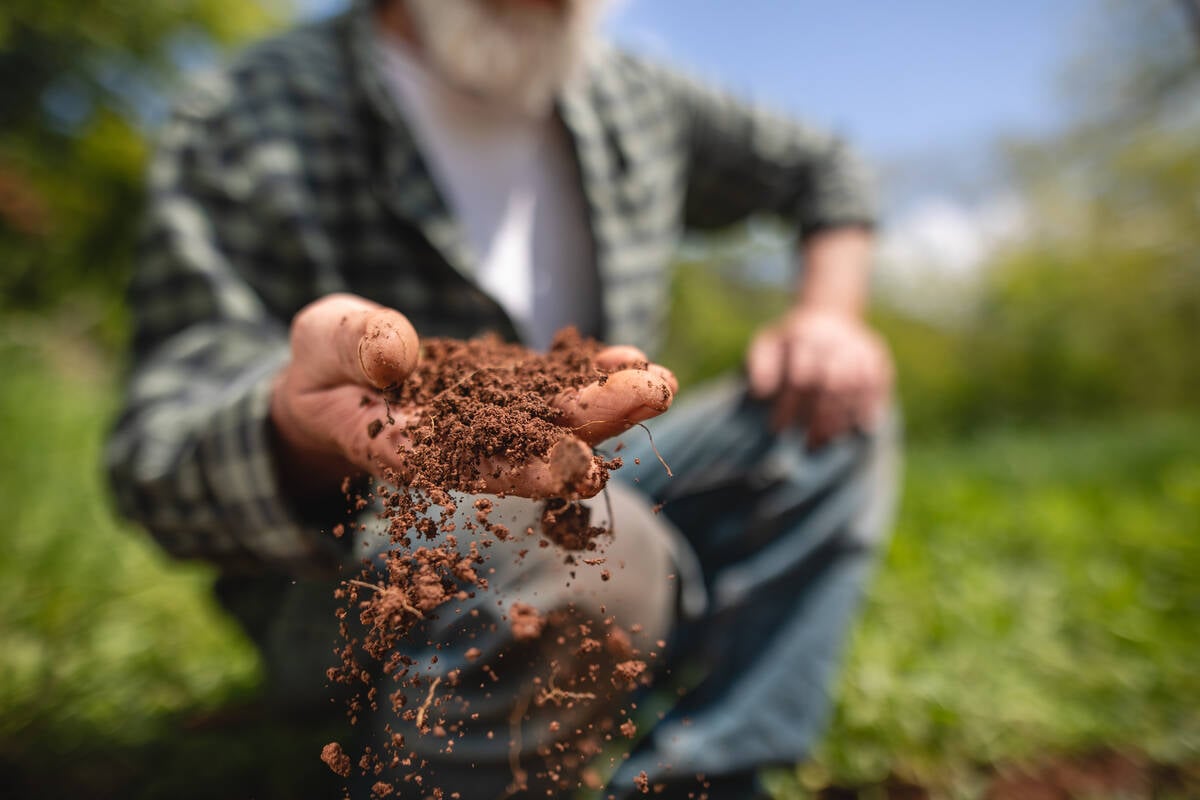
Finally getting paid for sustainable farming?
Alberta project says they might have a line on a workable ecosystem credit model to reward farmers for sustainability, and Manitoba might be next
Why it matters: Beekeepers seemed poised as yet another casualty of Manitoba’s drought in midsummer, but a late flush of growth has helped the sector creep closer to a normal season.
Honey yields this year still fell below normal, according to Steppler, although final numbers were not nearly as grim as many worried in July.
A season summary from Manitoba Agriculture and Resource Development estimates that hives in Manitoba produced an average 160.8 pounds of honey per colony in 2021, compared to the historic average of 170 pounds per colony.
In the northwest, beekeepers saw almost normal yields, with 168.2 pounds per colony on average. Both eastern and central Manitoba, meanwhile, reported 162.6 and 162.7 pounds per colony, respectively.
“I think we did a lot better than we anticipated,” provincial apiarist Rhéal Lafrenière said. “It really was those little rains that we got, as well as, maybe, underestimating the bees. I think the bees just visited a lot more flowers to find that nectar and flew a little bit farther.”
In the southwest and Interlake, however, the tail end of the season could not overcome earlier impacts. Yields in the southwest dropped to 150.6 pounds a colony, while Interlake producers saw only an average of 125.1 pounds per colony.
“Even though there were some rains that occurred, I think (the Interlake) was so hard hit, so drought stressed, that many of those plants just didn’t recover,” Lafrenière said.
- Read more: Bees impacted by pesky symptoms
The area also saw even lower production in July than other areas, he noted, leaving producers a deeper hole to fill in the back half of the season.
Lafrenière cautioned, however, that reported averages may not reflect every farm. Yields even within those regions were highly variable this year, he noted, and some producers even in the Interlake reported good yields.
Swing season
It’s a roller-coaster end to what has been an up-and-down season.
Signs were good for beekeepers starting out 2021, although a dry spring was already lending some caution to early predictions. Still, honey prices were high and winter had been kind. Bee yards in Manitoba had seen winter mortalities around 15.4 per cent, the low end of the estimated 15 to 25 per cent mortality of a typical year.
As the season progressed, however, that optimism shifted to alarm as the scope and severity of Manitoba’s historic drought became clear. By mid-July, parts of the province had been months without substantial rain, compounded by lack of rain and snow stretching back into the previous year. The Canadian Drought Monitor reported that much of the province was experiencing anywhere from a one-in-20- to one-in-50-year drought, while high temperatures added yet another stress and threatened canola crops, typically a mainstay for beekeepers. Beekeepers were forced to consider supplemental feed.
“Right about that time, boy, things looked pretty desperate… pretty much across Manitoba, canola crops were being burnt off, no rains coming through, and just that extreme heat, the dryness, and also compounded with smoke,” Steppler said, referencing the widespread haze blown in from forest fires this summer. “There were some days here through July that we had like half a mile of visibility.”
In those smoky conditions, bees were more likely to ‘beard’ on the front of the colony than leave the hive and work, he said.
Early-summer months saw the association join many other farm groups raising drought concerns and requests for aid with the provincial government, including a request for AgriRecovery.
An assessment by the province in July found beekeepers were under 75 per cent of normal production at that time, Steppler noted. Added to that, the calendar was drawing closer to a period in which hives build up condition for winter, and lack of feed was a significant concern.
Then, the taps turned on.
August rains gave, “just a little bit of reprieve” and revitalized perennial plants, providing much-needed pollen and nectar, Steppler said.
That, in turn, got the honey flowing once again.
Conditions eventually improved enough that the producers’ group withdrew its AgriRecovery request.
Market advantage
Record honey prices are also expected to close the financial gap, even in areas where harvest was slim.
Last year’s swell in the honey market — linked to the rise of pandemic-driven baking sprees at the same time as shipment issues and lower domestic production contracted supply — has yet to deflate. In May 2021, Manitoba beekeepers reported prices of $2.25 to $2.35 per pound, and as high as $2.85 on the high end.
As of October, Steppler said prices ranged around $2.80 a pound.
“That’s almost double from last year,” he said, adding that those prices are for bulk shipments.
“I’m talking to other producers who are selling smaller lots to smaller packers for $3.25 a pound, which is exceptional. So long as I’ve been beekeeping, we’ve never seen prices that high,” he added.
Those prices will likely keep producers out of economic trouble if their harvests were significantly short, Lafrenière said, although missed profit, had yields been better, will certainly sting.
Ready for winter
The reprieve has also set hives on better footing for the winter.
Beekeepers had previously worried that drought conditions would adversely affect the switch to winter brood — bees with higher fat content and lifespans up to six months, compared to the six- to eight-week life of summer bees. That switch is triggered by shortened days, Lafrenière noted earlier this year.
In mid-July, beekeepers reported that brood production had already slowed as feed sources dried up, raising the possibility that hives might not produce enough winter bees without supplemented feed.
That worry, both Steppler and Lafrenière say, is in the rear-view mirror. Rain and warm temperatures have led to a sudden flush of plant life, including new-growth canola burst back into bloom.
“A lot of beekeepers are satisfied by the way their hives are setting themselves up for winter,” Steppler said, although he noted that an unusually warm fall has thrown hives “just a bit of a curveball.”
“We set them up for winter in August and September and suddenly we’re having all these fields of flowers provide pollen and nectar for our hives again,” he said, noting that hives have doubled down on brood production, in a time when they would normally be shutting down for winter.
He is unsure whether that will be an issue for overwintering.
Lafrenière, however, is not seriously concerned.
Hives did only begin to shut down brood production in mid-October, a month later than typical and two months later than feared earlier this year, he said.
At the same time, he argued, “I don’t think it’s going to be a bad delay.
“I think there was that gradual wind-down of brood production, so that they were still investing in winter bees… the season didn’t turn completely upside down. It just got extended.”





